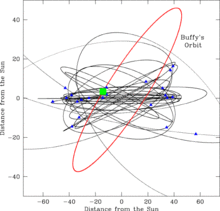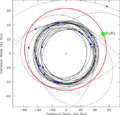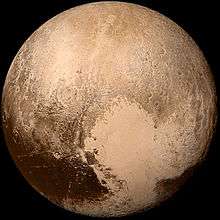2004 XR190
| Discovery[1] | |
|---|---|
| Discovered by |
Lynne Jones Brett Gladman John J. Kavelaars Jean-Marc Petit Joel Parker Phil Nicholson |
| Discovery date | 11 December 2004 |
| Designations | |
| MPC designation | 2004 XR190 |
| none | |
|
cubewano[2] detached object | |
| Orbital characteristics[3] | |
| Epoch 13 January 2016 (JD 2457400.5) | |
| Uncertainty parameter 3 | |
| Observation arc | 2957 days (8.10 yr) |
| Aphelion | 63.933 AU (9.5642 Tm) (Q) |
| Perihelion | 51.258 AU (7.6681 Tm) (q) |
| 57.595 AU (8.6161 Tm) (a) | |
| Eccentricity | 0.11003 (e) |
| 437.11 yr (159653 d) | |
| 277.502° (M) | |
| 0° 0m 8.118s /day (n) | |
| Inclination | 46.6656° (i) |
| 252.375042° (Ω) | |
| 282.724° (ω) | |
| Earth MOID | 50.557 AU (7.5632 Tm) |
| Jupiter MOID | 47.4512 AU (7.09860 Tm) |
| Physical characteristics | |
| Dimensions |
425–850 km (albedo 0.16–0.04)[4] 335–530 km (albedo 0.25–0.10)[5] |
| < 0.25? | |
| 22.04[6] | |
| 4.3[3] | |
|
| |
2004 XR190 is a possible dwarf planet[7] located in the scattered disc. It has a highly inclined low-eccentricity orbit. It was discovered in December 2004.
History
Discovery
2004 XR190 was discovered on 11 December 2004. It was discovered by astronomers led by Lynne Jones of the University of British Columbia as part of the Canada–France Ecliptic Plane Survey (CFEPS) using the Canada–France–Hawaii Telescope (CFHT) near the ecliptic. In 2015, six precovery images from 2002 and 2003 were found in Sloan Digital Sky Survey data.
Naming
The discovery team nicknamed 2004 XR190 "Buffy", after the fictional vampire slayer,[8] and proposed several Inuit-based official names to the IAU.
Orbit
Considered a detached object,[9][10] 2004 XR190 is particularly unusual for two reasons. With an inclination of 47 degrees, it is the largest possible dwarf planet that has an inclination larger than 45 degrees,[11] traveling further "up and down" than "left to right" around the Sun when viewed edge-on along the ecliptic. Second, it has an unusually circular orbit for a scattered-disc object (SDO). Although it is thought that traditional scattered-disc objects have been ejected into their current orbits by gravitational interactions with Neptune, the low eccentricity of its orbit and the distance of its perihelion (SDOs generally have highly eccentric orbits and perihelia less than 38 AU) seems hard to reconcile with such celestial mechanics. This has led to some uncertainty as to the current theoretical understanding of the outer Solar System. The theories include close stellar passages, rogue planets/planetary embryos in the early Kuiper belt, and resonance interaction with an outward-migrating Neptune. The Kozai mechanism is capable of transferring orbital eccentricity to a higher inclination.[4]
2004 XR190 came to aphelion around 1901.[12] Other than long-period comets, it is currently about the thirteenth-most-distant known large body (57.5 AU) in the Solar System with a well-known orbit, after Eris and Dysnomia (96.3 AU), 2007 OR10 (87.4 AU), Sedna (85.9 AU), 2014 FC69 (84.0 AU), 2006 QH181 (83.3 AU), 2012 VP113 (83.3 AU), 2013 FY27 (80.3 AU), 2010 GB174 (70.5 AU), 2000 CR105 (60.3 AU), 2003 QX113 (59.8 AU), and 2008 ST291 (59.6 AU).[13]
-

A side view of 2004 XR190's orbit, showing its high inclination. Units in AU.
Size
2004 XR190 has a diameter estimated at around 500 kilometres (310 mi), roughly a quarter the size of Pluto, and it orbits between 51 and 64 AU (7.7 and 9.5 billion kilometers) from the Sun.
See also
References
- ↑ "MPEC 2005-X72 : 2004 XR190". IAU Minor Planet Center. 2005-12-12. Retrieved 2014-04-06. (K04XJ0R)
- ↑ "2004 XR190 Orbit" (arc=2221 days over 5 oppositions). IAU Minor Planet Center. Retrieved 2014-04-06.
- 1 2 "JPL Small-Body Database Browser: (2004 XR190)" (2011-01-10 last obs). Retrieved 30 March 2016.
- 1 2 R. L. Allen; B. Gladman (2006). "Discovery of a low-eccentricity, high-inclination Kuiper belt object at 58 AU". The Astrophysical Journal. 640: L83. arXiv:astro-ph/0512430
 . Bibcode:2006ApJ...640L..83A. doi:10.1086/503098. (Discovery paper)
. Bibcode:2006ApJ...640L..83A. doi:10.1086/503098. (Discovery paper)
- ↑ E. L. Schaller & M. E. Brown (2007). "Volatile loss and retention on Kuiper belt objects" (PDF). Astrophysical Journal. 659: I.61–I.64. Bibcode:2007ApJ...659L..61S. doi:10.1086/516709. Retrieved 2008-04-02.
- ↑ "AstDys 2004 XR190 Ephemerides". Department of Mathematics, University of Pisa, Italy. Archived from the original on 26 May 2011. Retrieved 2011-05-16.
- ↑ Michael E. Brown. "How many dwarf planets are there in the outer solar system? (updates daily)". California Institute of Technology. Retrieved 18 September 2016.
- ↑ Maggie McKee. "Strange new object found at edge of Solar System". New Scientist. Retrieved 2014-04-05.
- ↑ Jewitt, David, Morbidelli, Alessandro, & Rauer, Heike. (2007). Trans-Neptunian Objects and Comets: Saas-Fee Advanced Course 35. Swiss Society for Astrophysics and Astronomy. Berlin: Springer. ISBN 3-540-71957-1.
- ↑ Lykawka, Patryk Sofia & Mukai, Tadashi. (2007). Dynamical classification of trans-neptunian objects: Probing their origin, evolution, and interrelation. Icarus Volume 189, Issue 1, July, Pages 213–232. doi:10.1016/j.icarus.2007.01.001.
- ↑ "JPL Small-Body Database Search Engine: H < 6.5 (mag)". JPL Solar System Dynamics. Retrieved 2014-03-27.
- ↑ "Horizon Online Ephemeris System". California Institute of Technology, Jet Propulsion Laboratory. Retrieved 2009-03-23.
- ↑ AstDyS-2 list of minor planets more than 57.0 AU from the Sun
External links
![]() Media related to 2004 XR190 at Wikimedia Commons
Media related to 2004 XR190 at Wikimedia Commons
- MPEC circular detailing discovery
- Discovery webpage by research team
- Maggie McKee (13 December 2005). "Strange new object found at edge of Solar System". New Scientist. Archived from the original on 25 January 2006. Retrieved 14 December 2005.
- Canada-France-Hawaii Telescope Legacy Survey
- Orbital simulation from JPL (Java) / Ephemeris
- 2004 XR190 at the JPL Small-Body Database


_(cropped).jpg)
